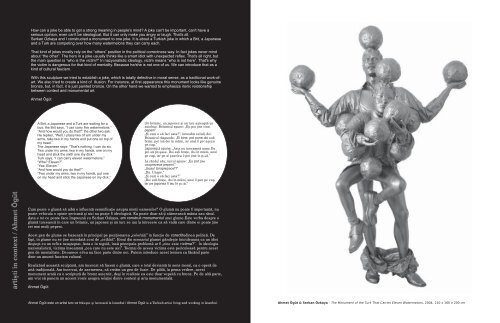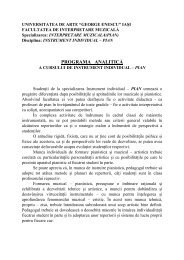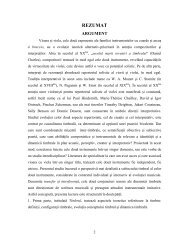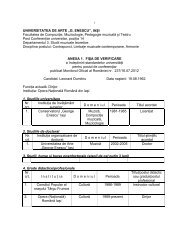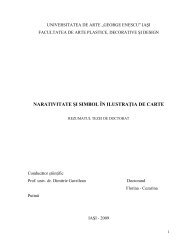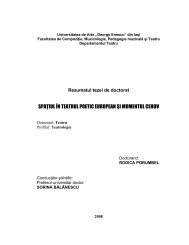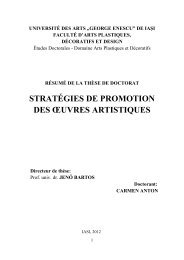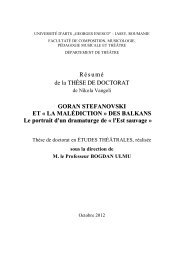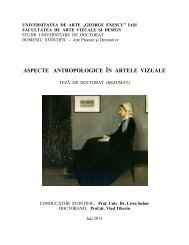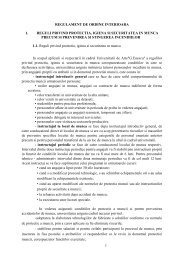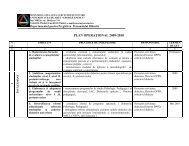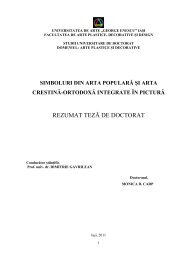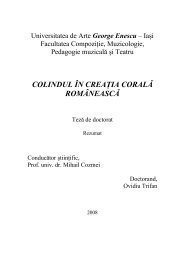vector 2_1.cdr - Universitatea de Arte "George Enescu"
vector 2_1.cdr - Universitatea de Arte "George Enescu"
vector 2_1.cdr - Universitatea de Arte "George Enescu"
You also want an ePaper? Increase the reach of your titles
YUMPU automatically turns print PDFs into web optimized ePapers that Google loves.
artişti în context / Ahmet Ögüt<br />
How can a joke be able to get a strong meaning in people's mind? A joke can't be important, can't have a<br />
serious opinion, even can't be i<strong>de</strong>ological. But it can only make you angry or laugh. That's all.<br />
Serkan Ozkaya and I constructed a monument to one joke. It is about a Turkish joke in which a Brit, a Japanese<br />
and a Turk are competing over how many watermelons they can carry each.<br />
That kind of jokes mostly rely on the “others” position in the political correctness way. In fact jokes never mind<br />
about “the other”. The hero in a joke usually thinks like a smart idiot with unexpected reflex. That's all right, but<br />
the main question is “who is the victim?” In nazyonalistic i<strong>de</strong>ology, victim means “who is not here”. That's why<br />
the victim is dangerous for that kind of mentality. Because he/she is not one of us. We can introduce that as a<br />
kind of cultural fascism.<br />
With this sculpture we tried to establish a joke, which is totally <strong>de</strong>fective in moral sense, as a traditional work-ofart.<br />
We also tried to create a kind of illusion. For instance, at first appearance this monument looks like genuine<br />
bronze, but, in fact, it is just painted bronze. On the other hand we wanted to emphasize ironic relationship<br />
between context and monumental art.<br />
Ahmet Ögüt<br />
A Brit, a Japanese and a Turk are waiting for a<br />
bus, the Brit says, “I can carry five watermelons.”<br />
“And how would you do that?” the other two ask.<br />
He replies, “Well, I place two of' em un<strong>de</strong>r my<br />
arms, take two in my hands and put one on top of<br />
my head.”<br />
The Japanese says: “That's nothing. I can do six.<br />
Two un<strong>de</strong>r my arms, two in my hands, one on my<br />
head and stick the sixth one my dick.”<br />
Turk says, “I can carry eleven watermelons.”<br />
“Wha? Eleven?”<br />
“Yea. Eleven.”<br />
“And how would you do that?”<br />
“Two un<strong>de</strong>r my arms, two in my hands, put one<br />
on my head and stick the Japanese on my dick.”<br />
Un britanic, un japonez şi un turc aşteaptă un<br />
autobuz. Britanicul spune: „Eu pot ţine cinci<br />
pepeni”.<br />
„Şi cum o să faci asta?”, întreabă ceilalţi doi.<br />
Britanicul răspun<strong>de</strong>: „Ei bine, pot pune doi sub<br />
braţe, pot lua doi în mâini, iar unul îl pot aşeza<br />
pe cap.”<br />
Japonezul spune: „Asta nu înseamnă nimic.Eu<br />
pot să ţin şase. Doi sub braţe, doi în mâini, unul<br />
pe cap, iar pe al şaselea îl pot ţine în p **<br />
ă.”<br />
La rândul său, turcul spune: „Eu pot ţine<br />
unsprezece pepeni.”<br />
„Uoau! Unsprezece!?”<br />
„Da. Unşpe.”<br />
„Şi cum o să faci asta?”<br />
„Doi sub braţe, doi în mâini, unul îl pun pe cap,<br />
iar pe japonez îl iau în p** ă.”<br />
Cum poate o glumă să aibă o influentă semnificaţie asupra minţii oamenilor? O glumă nu poate fi importantă, nu<br />
poate vehicula o opinie serioasă şi nici nu poate fi i<strong>de</strong>ologică. Ea poate doar să-ţi stârnească mânia sau râsul.<br />
Asta e tot ce poate face.Împreună cu Serkan Özkaya, am construit monumentul unei glume.Este vorba <strong>de</strong>spre o<br />
glumă turcească în care un britanic, un japonez şi un turc se iau la întrecere ca să vadă care dintre ei poate ţine<br />
cei mai mulţi pepeni.<br />
Acest gen <strong>de</strong> glume se bazează în principal pe poziţionarea „celorlalţi” în funcţie <strong>de</strong> corectitudinea politică. De<br />
fapt, în glume nu se ţine niciodată cont <strong>de</strong> „celălalt”. Eroul din scenariul glumei gân<strong>de</strong>şte întot<strong>de</strong>auna ca un idiot<br />
<strong>de</strong>ştept cu un reflex neaşteptat. Asta e în regulă, însă principala problemă ar fi „cine este victima?”. În i<strong>de</strong>ologia<br />
nazionalistică, victima înseamnă „cea care nu este aici”. Tocmai <strong>de</strong> aceea victima este periculoasă pentru acest<br />
gen <strong>de</strong> mentalitate. Deoarece el/ea nu face parte dintre noi. Putem introduce acest termen ca făcând parte<br />
dintr-un anumit fascism cultural.<br />
Realizând această sculptură, am încercat să facem o glumă, care e total <strong>de</strong>viantă în sens moral, ca o operă <strong>de</strong><br />
artă tradiţională. Am încercat, <strong>de</strong> asemenea, să creăm un gen <strong>de</strong> iluzie. De pildă, la prima ve<strong>de</strong>re, acest<br />
monument arată ca o sculptură <strong>de</strong> bronz autentic, <strong>de</strong>şi în realitate ea este doar vopsită cu bronz. Pe <strong>de</strong> altă parte,<br />
am vrut să punem un accent ironic asupra relaţiei dintre context şi arta monumentală.<br />
Ahmet Ögüt<br />
Ahmet Ögüt este un artist turc ce trăieşte şi lucrează la Istanbul / Ahmet Ögüt is a Turkish artist living and working in Istanbul.<br />
Ahmet Ögüt & Serkan Özkaya - The Monument of the Turk That Carries Eleven Watermelons, 2004, 210 x 160 x 200 cm


